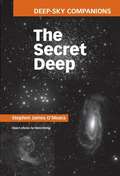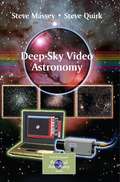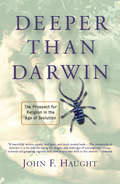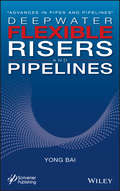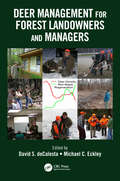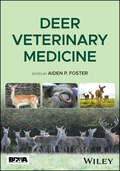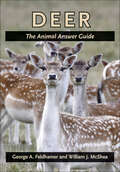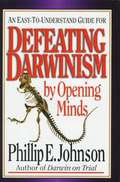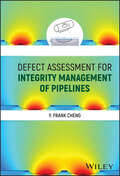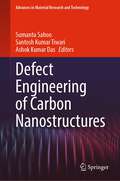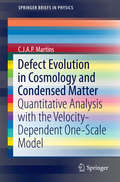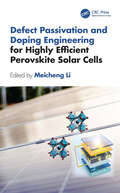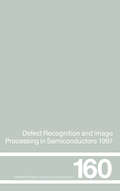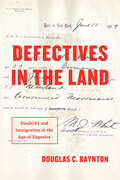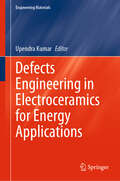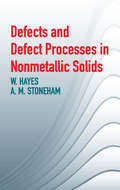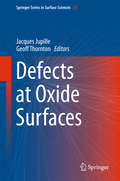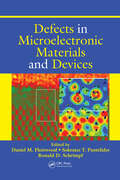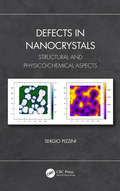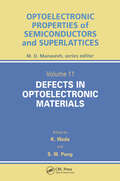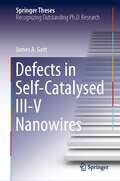- Table View
- List View
Deep-Sky Companions
by Stephen James O'MearaIf there were a canon for viewing the night sky, Charles Messier would be its author. The galaxies, star clusters, and nebulae cataloged by the famous comet hunter in the late 1700s are still the most widely observed celestial wonders in the heavens. They are the favorite targets of amateur astronomers, with such rich variety and detail that they never cease to fascinate. This book provides new and experienced observers with a fresh perspective on the Messier objects. Stephen James O'Meara has prepared a visual feast for the observer. Using the finest optical telescopes available for amateur work, he describes and sketches the view from the telescope as never before. There are new drawings, improved finder charts, and new astronomical data on each object, including findings from the Hubble Space Telescope. Expand your universe and test your viewing acumen with this truly modern Messier Guide. It is a must for budding night watchers. Stephen James O'Meara is a contributing editor to Sky and Telescope.
Deep-Sky Companions the Secret Deep
by Stephen James O'MearaIn this fresh list, Stephen James O'Meara presents 109 new objects for stargazers to observe. The Secret Deep list contains many exceptional objects, including a planetary nebula whose last thermal pulse produced a circumstellar shell similar to the one expected in the final days of our Sun's life; a piece of the only supernova remnant known visible to the unaided eye; the flattest galaxy known; the largest edge-on galaxy in the heavens; the brightest quasar; and the companion star to one of the first black hole candidates ever discovered. Each object is accompanied by beautiful photographs and sketches, original finder charts, visual histories and up-to-date astrophysical information to enrich the observing experience. Featuring galaxies, clusters and nebulae not covered in other Deep-Sky Companions books, this is a wonderful addition to the series and an essential guide for any deep-sky observer.
Deep-Sky Video Astronomy
by Steve Quirk Steve MasseyDeep-Sky Video Astronomy is a concise guide to using modern integrating video cameras for deep-sky viewing and imaging with the kinds of modest telescopes available commercially to amateur astronomers. It includes an introduction and a brief history of the technology, camera types, etc. The authors then examine the pros and cons of this unrefrigerated yet highly efficient technology, which is already beginning to compete with expensive astronomical cooled-chip CCD cameras in quality and ease of use. There is a thorough examination of accessories used to achieve particular results. Examples are focal reducers, Barlow lenses, and optical filters. However, the focus is mostly on the practical side of creating beautiful and detailed astronomical portraits using image-stacking software, enhancement tools like PhotoShop, and creating color images with a black-and-white camera. Practical step-by-step examples supported by tried and trusted tips show how to achieve the best possible deep-sky video portrait!
Deep-sky Companions
by O’meara Stephen JamesIn this fresh list, Stephen James O'Meara presents 109 new objects for stargazers to observe. The Secret Deep list contains many exceptional objects, including a planetary nebula whose last thermal pulse produced a circumstellar shell similar to the one expected in the final days of our Sun's life; a piece of the only supernova remnant known visible to the unaided eye; the flattest galaxy known; the largest edge-on galaxy in the heavens; the brightest quasar; and the companion star to one of the first black hole candidates ever discovered. Each object is accompanied by beautiful photographs and sketches, original finder charts, visual histories and up-to-date astrophysical information to enrich the observing experience. Featuring galaxies, clusters and nebulae not covered in other Deep-Sky Companions books, this is a wonderful addition to the series and an essential guide for any deep-sky observer.
Deeper Than Darwin: The Prospect for Religion in the Age of Evolution
by John F. HaughtIn his acclaimed book God After Darwin, John Haught argued that religious belief is wholly compatible with evolutionary biology. Now, in Deeper Than Darwin, he advances his argument further by saying that religious belief is even more revealing about life than Darwinism. Haught looks hard at the question of how, after Darwin, religions may plausibly claim to be bearers of truth and not just of meaning and adaptive consolation. While he assumes the fundamental correctness of evolutionary biology, he firmly rejects the non-scientific belief that evolutionary biology amounts to an adequate explanation of living phenomena. Even though Darwinism is illuminating, Haught argues, it by no means tells us everything we need to know about life, even in principle. To find the deepest, though certainly not the clearest, understandings of life and the universe, we may still profitably consult the religions of the world. Deeper Than Darwin takes up where God After Darwin left off, arguing that Darwin's vision is important and essentially correct but that we can still dig deeper in our understanding of what is going on in the life-story.
Deepwater Flexible Risers and Pipelines
by Yong BaiThe technology, processes, materials, and theories surrounding pipeline construction, application, and troubleshooting are constantly changing, and this new series, Advances in Pipes and Pipelines,, has been created to meet the needs of engineers and scientists to keep them up to date and informed of all of these advances. This second volume in the series focuses on flexible pipelines, risers, and umbilicals, offering the engineer the most thorough coverage of the state-of-the-art available. The authors of this work have written numerous books and papers on these subjects and are some of the most influential authors on flexible pipes in the world, contributing much of the literature on this subject to the industry. This new volume is a presentation of some of the most cutting-edge technological advances in technical publishing. The first volume in this series, published by Wiley-Scrivener, is Flexible Pipes, available at www.wiley.com. Laying the foundation for the series, it is a groundbreaking work, written by some of the world’s foremost authorities on pipes and pipelines. Continuing in this series, the editors have compiled the second volume, equally as groundbreaking, expanding the scope to pipelines, risers, and umbilicals. This is the most comprehensive and in-depth series on pipelines, covering not just the various materials and their aspects that make them different, but every process that goes into their installation, operation, and design. This is the future of pipelines, and it is an important breakthrough. A must-have for the veteran engineer and student alike, this volume is an important new advancement in the energy industry, a strong link in the chain of the world’s energy production
Deer Management for Forest Landowners and Managers
by David S. deCalesta and Michael C. EckleyThis book is designed to help landowners and forestry professionals develop, implement, and monitor programs to manage both deer and forests with emphasis on resolving deer impact issues. Chapters cover management strategies through identifying and setting goals; managing deer populations and deer impact on land; economics of forest, deer, and impact management; human dimensions of deer management; and developing and implementing integrated management plans. The book presents an integrated, quantitative approach for managing deer populations and impacts so users can manage forest resources sustainably.
Deer Veterinary Medicine
by Aiden P. FosterA guide to the care and treatment of deer for veterinary professionals Deer Veterinary Medicine is an essential reference for veterinary professionals preparing for deer encounters. Rooted in extensive field experience, the contributions from a range of authors provide details of common conditions across multiple deer species and the knowledge required by the veterinary professionals who deal with them. The book considers the different contexts where deer are encountered, including wild populations, and deer held in captivity (as farm, park and zoo collections). The chapters topics range from handling and sedating deer through to nutrition and postmortem examination and pathology. They cover key body systems including the gut, nervous, ocular and respiratory systems, and the skin. Deer Veterinary Medicine readers will also find: Detailed consideration of the use of sedation in deer, providing analgesia and methods of euthanasia.Coverage of species including red, roe, fallow, water deer, Reeves’ muntjac, reindeer and white-tailed deer.Coverage of veterinary interventions for reproductive purposes.Detailed consideration of the management of parasitic diseases.Detailed consideration of notifiable (including TB and CWD) and zoonotic diseases (including E. coli and cryptosporidiosis).A detailed drug formulary including, where available, evidence from published studies. Edited by the past president of the British Deer Veterinary Association (BDVA) this book is a fitting successor to Management and Diseases of Deer: A Handbook for Veterinary Surgeons, last published in 1994 by the Veterinary Deer Society (now the BDVA). Synthesizing key contributions by a range of experts from Europe and the US, the new Deer Veterinary Medicine is ideal for veterinarians, veterinary surgeons and veterinary students, as well as readers interested in the management of captive and wild deer.
Deer: The Animal Answer Guide (The Animal Answer Guides: Q&A for the Curious Naturalist)
by George A. Feldhamer William J. McSheaThink of deer and the image that pops into most American's minds is that of a white-tailed deer, the most common large mammal in North America. Most Europeans are more familiar with red deer. It may surprise many people to know that there are actually about 50 species of deer found throughout the world. Here, readers will find nontechnical, expert information about the wide range of diverse deer species. Did you know that elk and caribou are deer? Or that the earliest fossils of deer are 15 to 20 million years old? Have you ever wondered whether deer swim, play, or see color? How do deer avoid predators and survive the winter? Do deer make good pets or carry contagious diseases? George A. Feldhamer and William J. McShea answer these and other intriguing questions about members of the deer family Cervidae.From the diminutive pudu of South America that weighs 17 pounds to male moose that weigh close to 2,000 pounds, Feldhamer and McShea explore the biology, evolution, ecology, feeding habits, reproduction, and behavior of deer. They chronicle the relationships between humans and deer—both positive and negative—and discuss the challenges of deer conservation and management. With vivid color photographs and an accessible and engaging question-and-answer format, this easy-to-read book is the go-to resource on deer. Nature lovers, hunters, and anyone curious about deer will find this fact-filled book both fascinating and full of surprises.
Defeating Darwinism By Opening Minds
by Phillip E. JohnsonVoted one of Christianity Today's 1998 Books of the Year!For decades, Christians have felt voiceless in the critical debate over evolution. Until now. Finally, ordinary Christians have the opportunity and the resources to defeat the false claims of Darwinism. With all of the complicated scientific debate swirling around the topic of evolution, Christians need an easy way to understand the basic issues without oversimplifying. Phillip Johnson has the answer: the key to defeating the false claims of Darwinism is to open our minds to good thinking habits. Here is first-rate advice on avoiding common mistakes in discussions about evolution, understanding the legacy of the Scopes trial, spotting deceptive arguments, and grasping the basic scientific issues without getting bogged down in unnecessary details. In the bestselling and critically acclaimed Darwin on Trial and Reason in the Balance, Phillip Johnson took on the academic elites and exposed the misleading claims of evolutionary naturalism. Defeating Darwinism by Opening Minds provides a new and powerful treatment of these issues for high-school students, parents, teachers, pastors, youth advisors and ordinary readers. Johnson aims not just to defeat a bad theory, but to defeat it in the right way-by opening minds to the truth.
Defect Assessment for Integrity Management of Pipelines
by Y. Frank ChengDEFECT ASSESSMENT FOR INTEGRITY MANAGEMENT OF PIPELINES Make energy pipelines safer by improved defect assessment for integrity management Pipelines provide an effective and efficient mode for transportation of energies, including both conventional fossil fuels and renewable energies and fuels such as hydrogen, biofuels and carbon dioxide, over wide ranges and long distances, meeting economic development and civilian needs. While the integrity and safety of in-service pipelines is paramount to pipeline operators, there are many factors which can adversely affect the pipeline integrity and potentially result in pipeline failures and, sometimes, serious consequences. Defect Assessment for Integrity Management of Pipelines provides a thorough and detailed overview of various techniques that can be used to assess corrosion defects, the most common defects on pipelines, and other mechanical defects such as dents, buckles and winkles, all of which constitute essential threats to pipeline integrity. In addition to widely used standards and codes for defect assessment, readers can obtain the latest progress in development of advanced techniques for improved accuracy in defect assessment. From early-stage Level I methods to the newest Level III method integrating with the mechano-electrochemical interaction, Defect Assessment for Integrity Management of Pipelines has everything you need to improve safety of your pipelines. Defect Assessment for Integrity Management of Pipelines readers will also find: Evolution of defect assessment techniques and limitations to be overcome with improved techniques Detailed analysis of defect assessment for determination of fitness-for-service of the pipelines, and prediction of their failure pressures Both theoretical and practical aspects of the defect assessment methods applied on pipelines Defect Assessment for Integrity Management of Pipelines is ideal for pipeline professionals, researchers and graduate students to improve personal knowledge, research expertise, and technical skills.
Defect Engineering of Carbon Nanostructures (Advances in Material Research and Technology)
by Ashok Kumar Das Sumanta Sahoo Santosh Kumar TiwariThis book presents an analysis of the techniques used for the synthesis of innovative functional carbon nanostructures. The chapters describe the research and development of various layered carbon nanostructures. Emphasis is given to the impact of defects on carbon nanostructures. The application of carbon nanostructured materials in biomedical field and energy storage is described.
Defect Evolution in Cosmology and Condensed Matter
by C.J.A.P. MartinsThis book sheds new light on topological defects in widely differing systems, using the Velocity-Dependent One-Scale Model to better understand their evolution. Topological defects - cosmic strings, monopoles, domain walls or others - necessarily form at cosmological (and condensed matter) phase transitions. If they are stable and long-lived they will be fossil relics of higher-energy physics. Understanding their behaviour and consequences is a key part of any serious attempt to understand the universe, and this requires modelling their evolution. The velocity-dependent one-scale model is the only fully quantitative model of defect network evolution, and the canonical model in the field. This book provides a review of the model, explaining its physical content and describing its broad range of applicability.
Defect Passivation and Doping Engineering for Highly Efficient Perovskite Solar Cells (Advances in Materials Science and Engineering)
by Meicheng LiPerovskite solar cells (PSCs) have attracted increasing interest from researchers due to their superb power conversion efficiencies. The intrinsic trap defects, unavoidably formed in the fabrication process, can induce nonradiative recombination, ion migration, I-V hysteresis, and instability of PSCs. However, trap defects are not always harmful. Fully understanding the fundamentals of trap defects as well as the passivation and doping strategies is helpful for further improving device efficiency and stability. This book summarizes the methods and strategies of defect passivation and material doping aiming to clearly describe the underlying mechanisms for high-efficiency and stable PSCs.• Introduces the fundamental characteristics of perovskite material defects• Discusses the main strategies, principles, and applications of defect passivation• Describes defect passivation consequences and characterization methods• Covers principles, methods, and applications of doping engineering in perovskites• Explores the structural design, advantages, characteristics, fabrication methods, and future development of perovskite homojunctionEngineers and researchers working with photovoltaic generation, solar cells, semiconductors, and related topics will find this book to be an invaluable resource.
Defect Recognition and Image Processing in Semiconductors 1997: Proceedings of the seventh conference on Defect Recognition and Image Processing, Berlin, September 1997 (Institute Of Physics Conference Ser. #160)
by J. DonekerDefect Recognition and Image Processing in Semiconductors 1997 provides a valuable overview of current techniques used to assess, monitor, and characterize defects from the atomic scale to inhomogeneities in complete silicon wafers. This volume addresses advances in defect analyzing techniques and instrumentation and their application to substrates, epilayers, and devices. The book discusses the merits and limits of characterization techniques; standardization; correlations between defects and device performance, including degradation and failure analysis; and the adaptation and application of standard characterization techniques to new materials. It also examines the impressive advances made possible by the increase in the number of nanoscale scanning techniques now available. The book investigates defects in layers and devices, and examines the problems that have arisen in characterizing gallium nitride and silicon carbide.
Defectives in the Land: Disability and Immigration in the Age of Eugenics
by Douglas C. BayntonImmigration history has largely focused on the restriction of immigrants by race and ethnicity, overlooking disability as a crucial factor in the crafting of the image of the "undesirable immigrant." Defectives in the Land, Douglas C. Baynton's groundbreaking new look at immigration and disability, aims to change this. In the late nineteenth and early twentieth centuries, Baynton explains, immigration restriction in the United States was primarily intended to keep people with disabilities--known as "defectives"--out of the country. The list of those included is long: the deaf, blind, epileptic, and mobility impaired; people with curved spines, hernias, flat or club feet, missing limbs, and short limbs; those unusually short or tall; people with intellectual or psychiatric disabilities; intersexuals; men of "poor physique" and men diagnosed with "feminism." Not only were disabled individuals excluded, but particular races and nationalities were also identified as undesirable based on their supposed susceptibility to mental, moral, and physical defects. In this transformative book, Baynton argues that early immigration laws were a cohesive whole--a decades-long effort to find an effective method of excluding people considered to be defective. This effort was one aspect of a national culture that was increasingly fixated on competition and efficiency, anxious about physical appearance and difference, and haunted by a fear of hereditary defect and the degeneration of the American race.
Defects Engineering in Electroceramics for Energy Applications (Engineering Materials)
by Upendra KumarThis book highlights the history of electroceramics starting from synthesis using different routes of the solid solution to hybrid nanocomposites and its applications in different renewable energy, thermistor, actuators, thermoelectric, thermo-optic, sensor, and much more applications in electronic industry. In ceramic materials, the properties are controlled by doping and composition, but the grain size and the porosity of the sintered ceramics also play essential roles. The latter features depend on the method of fabrication. The end-user requirements define the optimum physical and chemical properties of ceramic materials. Therefore, the design and fabrication of ceramic components are multidisciplinary, spanning physical chemistry, metallurgy, and chemical engineering. Also included in this book are the various characterizing techniques to study the physical properties of ceramics.
Defects and Defect Processes in Nonmetallic Solids
by W. Hayes A. M. StonehamAcclaimed by Nature as "an ideal text," this extensive survey provides coverage of defects in nonmetals, emphasizing point defects and point-defect processes. It encompasses electronic, vibrational, and optical properties of defective solids and discusses extended defects such as dislocations and grain boundaries. 191 figures. 43 tables. 1985 edition.
Defects and Impurities in Silicon Materials
by Guido Langouche Yutaka YoshidaThis book emphasizesthe importance of the fascinating atomistic insights into the defects and theimpurities as well as the dynamic behaviors in silicon materials, which havebecome more directly accessible over the past 20 years. Such progress has beenmade possible by newly developed experimental methods, first principle theories,and computer simulation techniques. The book is aimed at young researchers, scientists, and technicians in related industries. The mainpurposes are to provide readers with 1) the basic physics behind defects insilicon materials, 2) the atomistic modeling as well as the characterizationtechniques related to defects and impurities in silicon materials, and 3) anoverview of the wide range of the research fields involved.
Defects and Impurities in Silicon Materials: An Introduction to Atomic-Level Silicon Engineering (Lecture Notes in Physics #916)
by Guido Langouche Yutaka YoshidaThis book emphasizes the importance of the fascinating atomistic insights into the defects and the impurities as well as the dynamic behaviors in silicon materials, which have become more directly accessible over the past 20 years. Such progress has been made possible by newly developed experimental methods, first principle theories, and computer simulation techniques. The book is aimed at young researchers, scientists, and technicians in related industries. The main purposes are to provide readers with 1) the basic physics behind defects in silicon materials, 2) the atomistic modeling as well as the characterization techniques related to defects and impurities in silicon materials, and 3) an overview of the wide range of the research fields involved.
Defects at Oxide Surfaces
by Jacques Jupille Geoff ThorntonThis book presents the basics and characterization of defects at oxide surfaces. It provides a state-of-the-art review of the field, containing information to the various types of surface defects, describes analytical methods to study defects, their chemical activity and the catalytic reactivity of oxides. Numerical simulations of defective structures complete the picture developed. Defects on planar surfaces form the focus of much of the book, although the investigation of powder samples also form an important part. The experimental study of planar surfaces opens the possibility of applying the large armoury of techniques that have been developed over the last half-century to study surfaces in ultra-high vacuum. This enables the acquisition of atomic level data under well-controlled conditions, providing a stringent test of theoretical methods. The latter can then be more reliably applied to systems such as nanoparticles for which accurate methods of characterization of structure and electronic properties have yet to be developed. The book gives guidance to tailor oxide surfaces by controlling the nature and concentration of defects. The importance of defects in the physics and chemistry of metal oxide surfaces is presented in this book together with the prominent role of oxides in common life. The book contains contributions from leaders in the field. It serves as a reference for experts and beginners in the field.
Defects in Microelectronic Materials and Devices
by Daniel M. Fleetwood Sokrates T. Pantelides Ronald D. SchrimpfUncover the Defects that Compromise Performance and ReliabilityAs microelectronics features and devices become smaller and more complex, it is critical that engineers and technologists completely understand how components can be damaged during the increasingly complicated fabrication processes required to produce them.A comprehensive survey of defe
Defects in Nanocrystals: Structural and Physico-Chemical Aspects
by Sergio PizziniDefects in Nanocrystals: Structural and Physico-Chemical Aspects discusses the nature of semiconductor systems and the effect of the size and shape on their thermodynamic and optoelectronic properties at the mesoscopic and nanoscopic levels. The nanostructures considered in this book are individual nanometric crystallites, nanocrystalline films, and nanowires of which the thermodynamic, structural, and optical properties are discussed in detail. The work: Outlines the influence of growth processes on their morphology and structure Describes the benefits of optical spectroscopies in the understanding of the role and nature of defects in nanostructured semiconductors Considers the limits of nanothermodynamics Details the critical role of interfaces in nanostructural behavior Covers the importance of embedding media in the physico-chemical properties of nanostructured semiconductors Explains the negligible role of core point defects vs. surface and interface defects Written for researchers, engineers, and those working in the physical and physicochemical sciences, this work comprehensively details the chemical, structural, and optical properties of semiconductor nanostructures for the development of more powerful and efficient devices.
Defects in Optoelectronic Materials
by Kazumi WadaDefects in Optoelectronic Materials bridges the gap between device process engineers and defect physicists by describing current problems in device processing and current understanding of these defects based on defect physics. The volume covers defects and their behaviors in epitaxial growth, in various processes such as plasma processing, deposition and implantation, and in device degradation. This book also provides graduate students cutting-edge information on devices and materials interaction.
Defects in Self-Catalysed III-V Nanowires (Springer Theses)
by James A. GottThis thesis presents an in-depth exploration of imperfections that can be found in self-catalysed III-V semiconductor nanowires. By utilising advanced electron microscopy techniques, the interface sharpness and defects at the atomic and macroscopic scale are analysed. It is found that a surprising variety and quantity of defect structures can exist in nanowire systems, and that they can in fact host some never-before-seen defect configurations. To probe how these defects are formed, conditions during nanowire growth can be emulated inside the microscope using the latest generation of in-situ heating holder. This allowed the examination of defect formation, dynamics, and removal, revealing that many of the defects can in fact be eliminated. This information is critical for attaining perfect nanowire growth. The author presents annealing strategies to improve crystal quality, and therefore device performance.

